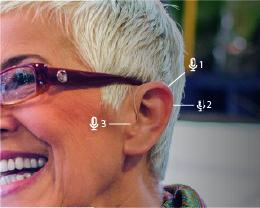
What Makes M&RIE So Groundbreaking?
Our most advanced hearing solution yet, Beltone Imagine, can be configured as a traditional RIE (Receiver-in-Ear) or as a new class of device with M&RIE (Microphone & Receiver-In-Ear). With the M&RIE receiver, we are putting the microphone back where it belongs – in the ear canal. This unique placement lets your patients take full advantage of what the pinna was designed to do, allowing them to hear with their own ears for a truly tailored hearing experience. By combining the benefits of a RIE with the microphone placement benefits of a CIC (Completely-in-Canal), your patients can hear sound as nature intended.
How Does M&RIE Work?
Our outer ears, head and torso uniquely shape the sound that enters the ear canal, providing acoustic cues that the brain uses to help us orient to our environment, perceive the depth and direction of sounds, and untangle overlapping sounds. This shaping is as unique as every individual and what makes the sound natural to each person.

In addition to the two microphones on the hearing aid, the M&RIE receiver module includes a microphone that collects sound in the ear canal, preserving each individual detail.
With CrossLink Directionality 3, patients get the most natural sound quality with M&RIE in quiet and moderately complex environments, while the device microphones provide a boosted SNR in noisier situations.
Why People Prefer Beltone Imagine With M&RIE?
Satisfied patients consistently report benefit such as:
Natural Sound Quality With Depth And Detail
%
of listeners prefer M&RIE for natural sound quality. (1)
Wind Noise Protection
natural wind protection without reducing gain. (3)
Better Localization And Spatial Awareness
%
fewer front-back confusions than a traditional RIE. (2). This is because using the pinna to collect sounds gives the user a better sense of depth and direction, with significantly better overall localization.
Easy, Natural Phone Placement For Calls
%
of patients report effortless non-streamed phone calls with M&RIE. (4)
- With mild hearing loss compared to pinna restoration and omnidirectional. Groth 2020.
- With mild hearing loss compared to standard RIE with pinna restoration. Jespersen et al 2020.
- Compared to omnidirectional at wind speed of 5 m/s. Groth 2020.
- Percentage of patients who report regular calls without effort or very little effort. Hartenstein, R.W. & Quilter, M.E. 2021. Subjective experience of telephone listening with M&RIE.
